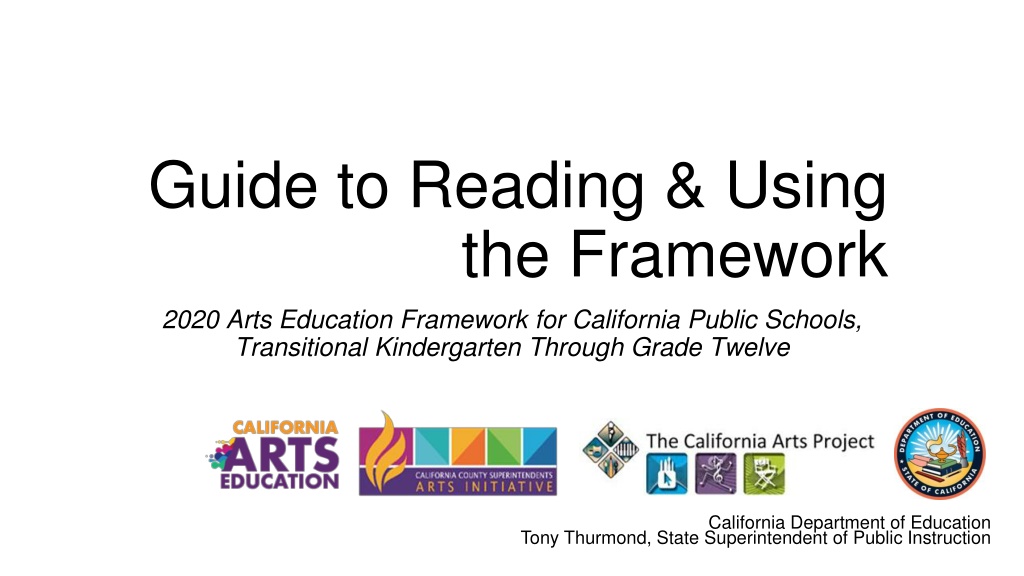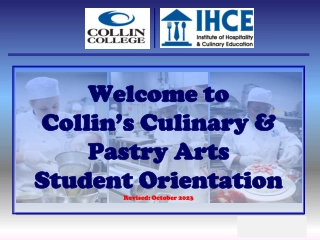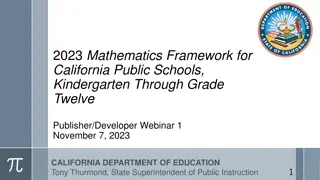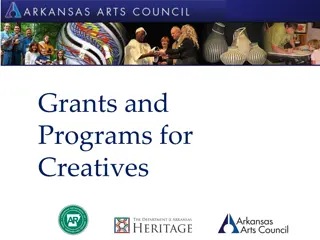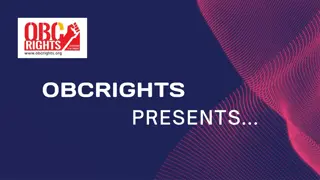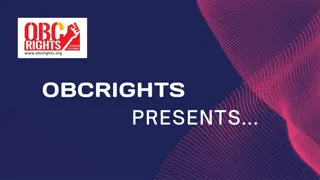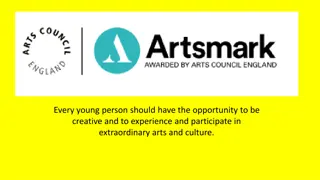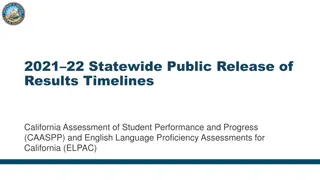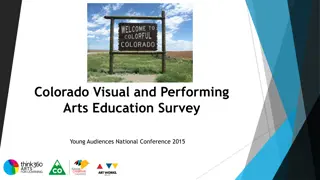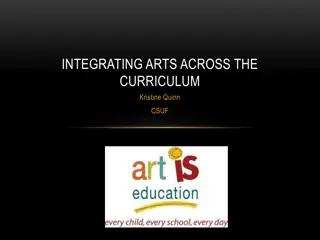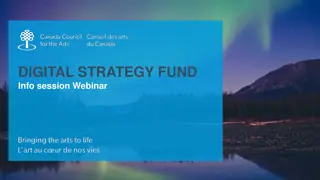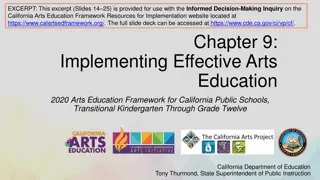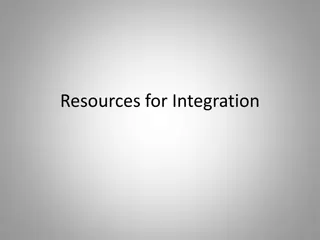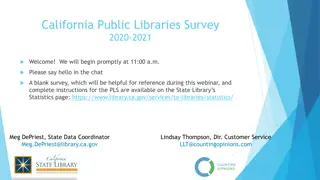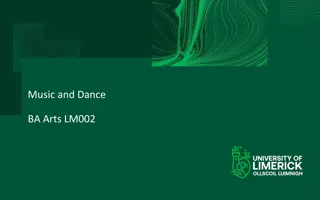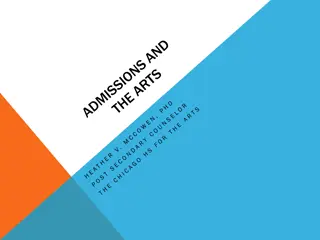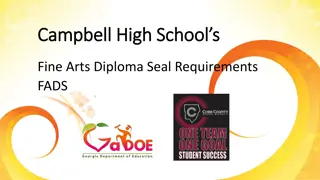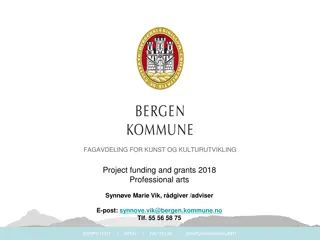Understanding the 2020 Arts Education Framework for California Public Schools
Explore the Arts Education Framework for California Public Schools, which provides guidance for transitional kindergarten through grade twelve. Discover the guiding documents, the audience for the framework, and how it supports arts education in the state. Learn about the organization of the framework and key content highlights to enhance arts education practices.
Download Presentation

Please find below an Image/Link to download the presentation.
The content on the website is provided AS IS for your information and personal use only. It may not be sold, licensed, or shared on other websites without obtaining consent from the author. Download presentation by click this link. If you encounter any issues during the download, it is possible that the publisher has removed the file from their server.
E N D
Presentation Transcript
Guide to Reading & Using the Framework 2020 Arts Education Framework for California Public Schools, Transitional Kindergarten Through Grade Twelve California Department of Education Tony Thurmond, State Superintendent of Public Instruction
Introduction to the Guide to Reading and Using the Framework The goal of the guide is to highlight what is in the Arts Framework so that readers may determine which chapters best support their needs at any given time. The Guide explains the purpose of the Framework; identifies the audience for the Framework; and provides an overview of the content of the Framework. 2
Questions for the Guide to Reading and Using the Framework 1. What are the guiding documents for arts education in California? 2. Who might use the Arts Framework? 3. What is the difference between standards and frameworks? 4. How is the Arts Framework organized, and what are some content highlights? 3
Q1What are the guiding documents for arts education in California? 4
Documents That Guide Arts Education in California The California Preschool Learning Foundations Volume 2 (preschool) The 2019 California Arts Standards (transitional kindergarten through grade twelve) The 2020 Arts Framework (transitional kindergarten through grade twelve) California Career Technical Education Model Curriculum Standards for Arts Media and Entertainment (grades eight through twelve may include courses aligned to these standards) 5
A Note About Prekindergarten vs. Transitional Kindergarten The Arts Framework provides guidance for implementation of the prekindergarten (PK) arts standards which are intended for use in transitional kindergarten (TK). In the Arts Framework, the PK standards from the Arts Standards document are referred to as TK standards. PK educators should use the California Preschool Learning Foundations, Volume 2, which addresses the development of children 36 to 48 months. 6
Q2Who might use the Arts Framework? 7
The Arts Education Framework has Many Audiences Local Educational Agencies (TK 12 Educators, Administrators, School Counselors, etc.) Community Partners Policymakers Arts Education Advocates Developers and Publishers of Instructional Materials Professional Artists Museum Educators Institutions of Higher Education Arts Community Partners Parents/Caregivers/Families 8
Sample Entry Points for Different Users (1) For a single subject dance teacher Read Chapter 3: Dance. Read and cross-reference with Chapter 2: The Instructional Cycle, to get a broader understanding of some of the discussions around instruction. For an elementary generalist: Read Chapter 1: Vision and Goals for Standards-Based Arts Education. Read Chapter 8: Transcending Disciplinary Boundaries Arts Integration. Read specific discipline chapters to plan foundational arts learning experiences to build into an integrated unit or lesson. 9
Sample Entry Points for Different Users (2) For an administrator Read Chapter 1 and Chapter 9: Implementing Effective Arts Education. Work with designated leaders such as teachers on special assignment to use Chapter 2 to plan professional learning experiences to support arts teachers. For a parent or community arts educator Use Chapter 1 and some discipline-specific chapters for a better understanding of what to expect in the arts learning experiences students are getting in school. 10
Q3What is the difference between standards and frameworks? 11
Standards and Frameworks: What is the Difference? Standards The what for instruction What we want students to know, understand, and be able to do End of a grade level End of their school career Frameworks The how for instruction Guidance for educational programs Provide content for different users Reflect current and confirmed research Meet the needs of ALL students 12
Q4How is the Arts Framework organized, and what are some content highlights? 13
How is the Framework Organized? Guide to Reading and Using the Framework Chapter 1: Vision and Goals for Standards-Based Arts Education Chapter 2: The Instructional Cycle Chapters 3 7: Discipline-Specific Chapters Chapter 8: Transcending Disciplinary Boundaries Arts Integration Chapter 9: Implementing Effective Arts Education Chapter 10: Instructional Materials Appendices 14
Chapter 1: Vision and Goals for Standards- Based Arts Education Philosophy & goals of the standards Definition of artistic literacy Connection to social emotional learning (SEL) Access and equity Framework Highlights 15
Chapter 2: The Instructional Cycle Structure and intention of the standards Backward design and curriculum mapping Assessment approaches and methods Culturally and linguistically responsive teaching Universal Design for Learning (UDL) Framework highlights 16
The Discipline Chapters Chapter 3: Dance Chapter 4: Media Arts Chapter 5: Music Chapter 6: Theatre Chapter 7: Visual Arts Each discipline chapter includes discipline-specific explanations and approaches to Universal Design for Learning (UDL); Culturally and Linguistically Responsive Teaching; Students who are English Learners; Students with Disabilities; and Considerations for instruction in the discipline. Framework Highlights 17
Chapter 8: Transcending Disciplinary Boundaries Arts Integration Articulates a co-equal approach to arts integration Provides models and examples including how arts teachers and non-arts teachers might collaborate to plan and implement integrated instruction Framework Highlights 18
Chapter 9: Implementing Effective Arts Education (1) Guidance for administrators on effective and equitable arts education programs Improving arts education through strategic program evaluation and planning Discussion of the Opportunity to Learn Standards, which LEAs can use to evaluate their programs Engaging in leadership and advocacy for arts education Framework Highlights Professional learning 19
Chapter 9:Implementing Effective Arts Education (2) The arts are not a frill. The arts are a response to our individuality and our nature and help to shape our identity. What is there that can transcend deep difference and stubborn divisions? The arts. They have a wonderful universality. Art has the potential to unify. It can speak in many languages without a translator. The arts do not discriminate. The arts can lift us up. Barbara Jordan Former Congresswoman 20
Chapter 10 and Appendices Chapter 10: Instructional Materials Guidance for publishers of instructional materials to be used as criteria for the adoption of instructional materials Appendices: Links to resources California Education Code sections governing arts education programs Guidelines for safe use of artistic materials, tools, and appropriate performing teaching facilities Professional learning And more Framework Highlights 21
Reflection 22
